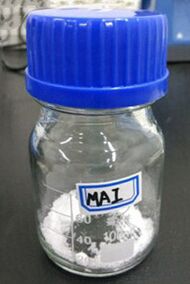Chemistry:Methylammonium halide: Difference between revisions
imported>Rtexter1 correction |
update |
||
| Line 1: | Line 1: | ||
{{Short description|Group of chemical compounds}} | |||
'''Methylammonium halides''' are [[Chemistry:Organic compound|organic]] [[Chemistry:Halide|halide]]s with a [[Chemistry:Chemical formula|formula]] of {{chem2|[CH3NH3]+X-}}, where X is F for methylammonium fluoride, Cl for [[Chemistry:Methylammonium chloride|methylammonium chloride]], Br for [[Chemistry:Methylammonium bromide|methylammonium bromide]], or I for [[Chemistry:Methylammonium iodide|methylammonium iodide]]. Generally they are white or light colored powders. | '''Methylammonium halides''' are [[Chemistry:Organic compound|organic]] [[Chemistry:Halide|halide]]s with a [[Chemistry:Chemical formula|formula]] of {{chem2|[CH3NH3]+X-}}, where X is F for methylammonium fluoride, Cl for [[Chemistry:Methylammonium chloride|methylammonium chloride]], Br for [[Chemistry:Methylammonium bromide|methylammonium bromide]], or I for [[Chemistry:Methylammonium iodide|methylammonium iodide]]. Generally they are white or light colored powders. | ||
==Applications== | ==Applications== | ||
[[File:CH3NH3I powder.jpg|thumb|upright|{{chem2|[CH3NH3]I}} powder]] | [[File:CH3NH3I powder.jpg|thumb|upright|{{chem2|[CH3NH3]I}} powder]] | ||
These salts are components of [[Physics:Perovskite solar cell|perovskite solar cell]]s, which are being evaluated for commercialization.<ref>{{cite journal|author=Li, Hangqian. |date=2016 |title=A modified sequential deposition method for fabrication of perovskite solar cells |journal=Solar Energy |volume=126 |pages=243–251 |doi=10.1016/j.solener.2015.12.045 |bibcode=2016SoEn..126..243L}}</ref> The iodide is the most commonly used. Magneto-optical data storage concepts are also being testing based on various ammonium halides.<ref name="Nafradi2016">{{cite journal|last1=Náfrádi|first1=Bálint|title=Optically switched magnetism in photovoltaic perovskite CH3NH3(Mn:Pb)I3|journal=Nature Communications|date=24 November 2016|volume=7| | These salts are components of [[Physics:Perovskite solar cell|perovskite solar cell]]s, which are being evaluated for commercialization.<ref>{{cite journal|author=Li, Hangqian. |date=2016 |title=A modified sequential deposition method for fabrication of perovskite solar cells |journal=Solar Energy |volume=126 |pages=243–251 |doi=10.1016/j.solener.2015.12.045 |bibcode=2016SoEn..126..243L}}</ref> The iodide is the most commonly used. Magneto-optical data storage concepts are also being testing based on various ammonium halides.<ref name="Nafradi2016">{{cite journal|last1=Náfrádi|first1=Bálint|title=Optically switched magnetism in photovoltaic perovskite CH3NH3(Mn:Pb)I3|journal=Nature Communications|date=24 November 2016|volume=7|article-number=13406|doi=10.1038/ncomms13406|arxiv=1611.08205|pmid=27882917|pmc=5123013|bibcode=2016NatCo...713406N}}</ref> | ||
==Production== | ==Production== | ||
| Line 9: | Line 11: | ||
==Crystallography== | ==Crystallography== | ||
These compounds' crystallography has been the subject of much investigation. J.S. Hendricks published an early paper on them in 1928.<ref>{{Citation|first1=J.S.|last1=Hendricks|year=1928|journal=Z. Kristallogr.|title=The crystal structures of the monomethyl ammonium halides|volume=67|issue=1|pages=106–118|doi=10.1524/zkri.1928.67.1.106|s2cid=101288454}}</ref> Methylammonium chloride was investigated again in 1946<ref>{{Citation|title=The Crystal Structure of Methylammonium Chloride|first1=Edward W.|last1=Hughes|first2=William N.|last2=Lipscomb|journal=J. Am. Chem. Soc.|year=1946|volume=68|issue=10|pages=1970–1975|doi=10.1021/ja01214a029}}</ref> and methylammonium bromide in 1961.<ref>{{Citation|title=The crystal structure of methylammonium bromide|journal=Acta Crystallogr.|year=1961|volume=14|issue=12|page=1296|last1=Gabe| | These compounds' crystallography has been the subject of much investigation. J.S. Hendricks published an early paper on them in 1928.<ref>{{Citation|first1=J.S.|last1=Hendricks|year=1928|journal=Z. Kristallogr.|title=The crystal structures of the monomethyl ammonium halides|volume=67|issue=1|pages=106–118|doi=10.1524/zkri.1928.67.1.106|s2cid=101288454}}</ref> Methylammonium chloride was investigated again in 1946<ref>{{Citation|title=The Crystal Structure of Methylammonium Chloride|first1=Edward W.|last1=Hughes|first2=William N.|last2=Lipscomb|journal=J. Am. Chem. Soc.|year=1946|volume=68|issue=10|pages=1970–1975|doi=10.1021/ja01214a029}}</ref> and methylammonium bromide in 1961.<ref>{{Citation|title=The crystal structure of methylammonium bromide|journal=Acta Crystallogr.|year=1961|volume=14|issue=12|page=1296|last1=Gabe|first1=E.J.|doi=10.1107/S0365110X6100382X|doi-access=free|bibcode=1961AcCry..14.1296G }}</ref> | ||
==See also== | ==See also== | ||
Latest revision as of 18:51, 21 October 2025
Methylammonium halides are organic halides with a formula of [CH
3NH
3]+
X−
, where X is F for methylammonium fluoride, Cl for methylammonium chloride, Br for methylammonium bromide, or I for methylammonium iodide. Generally they are white or light colored powders.
Applications

3NH
3]I powder
These salts are components of perovskite solar cells, which are being evaluated for commercialization.[1] The iodide is the most commonly used. Magneto-optical data storage concepts are also being testing based on various ammonium halides.[2]
Production
These compounds are usually prepared by combining equimolar amounts of methylamine with the appropriate halide acid. For instance methylammonium iodide is prepared by combining methylamine and hydrogen iodide at 0 °C for 120 minutes followed by evaporation at 60 °C, yielding crystals of methylammonium iodide.[3]
- CH
3NH
2 + HI → [CH
3NH
3]I
Crystallography
These compounds' crystallography has been the subject of much investigation. J.S. Hendricks published an early paper on them in 1928.[4] Methylammonium chloride was investigated again in 1946[5] and methylammonium bromide in 1961.[6]
See also
References
- ↑ Li, Hangqian. (2016). "A modified sequential deposition method for fabrication of perovskite solar cells". Solar Energy 126: 243–251. doi:10.1016/j.solener.2015.12.045. Bibcode: 2016SoEn..126..243L.
- ↑ Náfrádi, Bálint (24 November 2016). "Optically switched magnetism in photovoltaic perovskite CH3NH3(Mn:Pb)I3". Nature Communications 7. doi:10.1038/ncomms13406. PMID 27882917. Bibcode: 2016NatCo...713406N.
- ↑ Qiu, Jianhang; Qiu, Yongcai; Yan, Keyou; Zhong, Min; Mu, Cheng; Yan, He; Yang, Shihe (2013), "All-solid-state hybrid solar cells based on a new organometal halide perovskite sensitizer and one-dimensional TiO2 nanowire arrays", Nanoscale 5 (8): 3245–3248, doi:10.1039/C3NR00218G, PMID 23508213, Bibcode: 2013Nanos...5.3245Q
- ↑ Hendricks, J.S. (1928), "The crystal structures of the monomethyl ammonium halides", Z. Kristallogr. 67 (1): 106–118, doi:10.1524/zkri.1928.67.1.106
- ↑ Hughes, Edward W.; Lipscomb, William N. (1946), "The Crystal Structure of Methylammonium Chloride", J. Am. Chem. Soc. 68 (10): 1970–1975, doi:10.1021/ja01214a029
- ↑ Gabe, E.J. (1961), "The crystal structure of methylammonium bromide", Acta Crystallogr. 14 (12): 1296, doi:10.1107/S0365110X6100382X, Bibcode: 1961AcCry..14.1296G
 |

